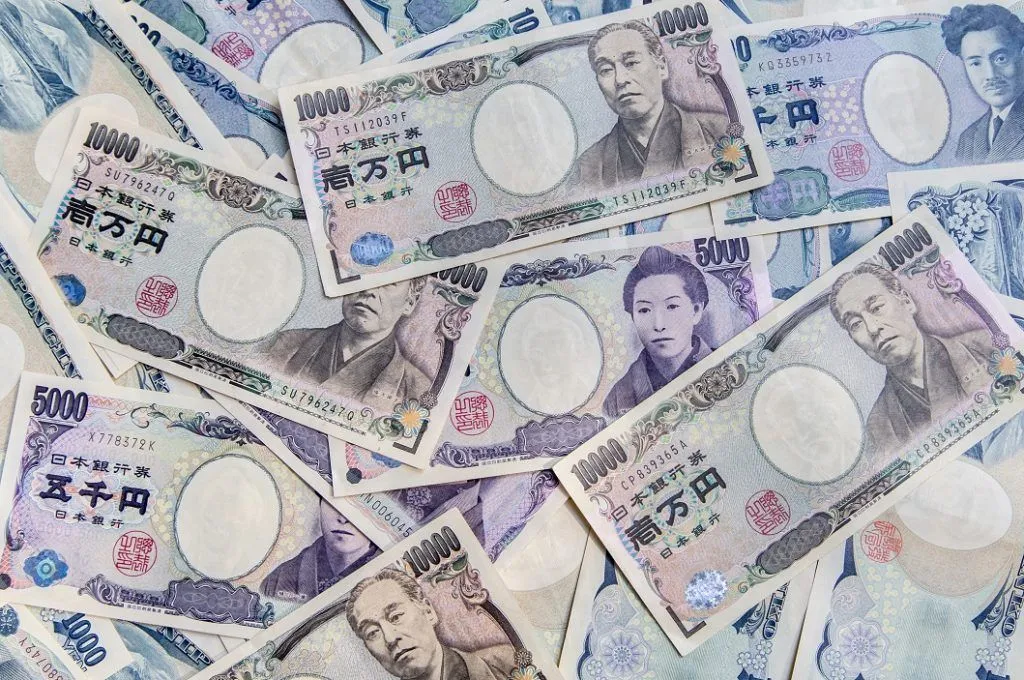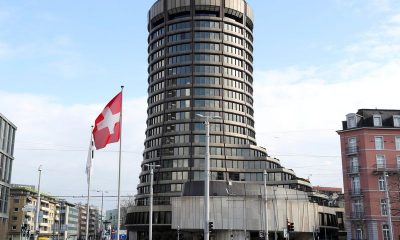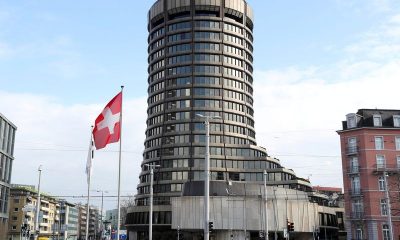Economy
Yen sags to 15-year low vs euro after BOJ rate decision

The yen plunged to a 15-year low against the euro on Friday after the Bank of Japan (BOJ) kept its ultra-low interest rate policy and forecast that inflation will slow later this year, in contrast with the European Central Bank’s (ECB) rate hike on Thursday.
The Japanese unit also fell against the greenback, dropping to a six-month trough.
As widely expected, the BOJ maintained its -0.1% short-term rate target and a 0% cap on the 10-year bond yield set under its yield curve control (YCC) policy.
BOJ Governor Kazuo Ueda said he expects inflation to moderate, but the “pace of decline is somewhat slow.”
The yen fell broadly following the decision and hit a fresh 15-year low of 155.22 per euro. It was poised for its biggest weekly decline against the euro in three years. The euro was last up 1.1 at 155.16 yen.
The dollar rose 1.1% against the Japanese currency to 141.795, after earlier touching its highest since November. It was on pace for its largest daily percentage gain since late April.
“The Bank of Japan added fuel to that dollar fire today by being on hold again,” said Erik Bregar, director, FX & precious metals risk management at Silver Gold Bull in Toronto.
Elsewhere, the euro was poised for its best week against the dollar since June after the ECB raised borrowing costs to a 22-year high and hinted at further tightening.
That and some soft U.S. data saw the dollar fall as traders scaled back bets on how high U.S. rates would need to rise.
The euro was flat against the greenback at $1.0940 after earlier touching a five-week high, having surged over 1% on Thursday following the rate hike and forward ECB guidance.
ECB President Christine Lagarde told a news conference another rate hike in July was highly likely and the central bank still has “ground to cover” to stave off high inflation.
Sterling rose 0.4% to $1.2831 after earlier rising to its highest since April 2022, as traders ramped up bets the Bank of England will raise rates for the 13th straight meeting next week.
FED FACES GRIM DATA
The ECB’s policy decision came a day after the Federal Reserve left rates unchanged, snapping a string of 10 consecutive hikes. However, the Fed also signalled that rates may still need to rise by as much as 50 basis points by the end of this year.
However, recent data showed U.S. economic activity is slowing and inflation is cooling, challenging the Fed’s still-hawkish stance.
On Friday, data showed ebbing inflation expectations that lifted U.S. consumer sentiment to a four-month high in June. The survey’s reading of one-year inflation expectations dropped to 3.3% this month from 4.2% in May.
In afternoon trading, the dollar index edged up 0.1% to 102.24, after falling to a five-week low on Thursday. It was on track for its weakest weekly performance since January.
“Beyond July, we don’t think there’s going to be another hike, but the first cut would be in December,” said Vassili Serebriakov, FX strategist at UBS in New York.
“We think the economy is going to slow meaningfully in the second half, with inflation coming in below what the Fed is expecting.”
Also on Friday, the U.S. Treasury said it found that no major U.S. trading partners had manipulated their currencies for an export advantage, adding it ended “enhanced analysis” for Switzerland after the country met only one of three manipulation criteria.
Economy
Russian central bank says it needs months to make sure CPI falling before rate cuts -RBC


© Reuters. Russian Central Bank Governor Elvira Nabiullina attends a news conference in Moscow, Russia June 14, 2019. REUTERS/Shamil Zhumatov/File Photo
MOSCOW (Reuters) – Russia’s central bank will need two to three months to make sure that inflation is steadily declining before taking any decision on interest rate cuts, the bank’s governor Elvira Nabiullina told RBC media on Sunday.
The central bank raised its key interest rate by 100 basis points to 16% earlier in December, hiking for the fifth consecutive meeting in response to stubborn inflation, and suggested that its tightening cycle was nearly over.
Nabiullina said it was not yet clear when exactly the regulator would start cutting rates, however.
“We really need to make sure that inflation is steadily decreasing, that these are not one-off factors that can affect the rate of price growth in a particular month,” she said.
Nabiullina said the bank was taking into account a wide range of indicators but primarily those that “characterize the stability of inflation”.
“This will take two or three months or more – it depends on how much the wide range of indicators that characterize sustainable inflation declines,” she said.
The bank will next convene to set its benchmark rate on Feb. 16.
The governor also said the bank should have started monetary policy tightening earlier than in July, when it embarked on the rate-hiking cycle.
Economy
China identifies second set of projects in $140 billion spending plan


© Reuters. FILE PHOTO: Workers walk past an under-construction area with completed office towers in the background, in Shenzhen’s Qianhai new district, Guangdong province, China August 25, 2023. REUTERS/David Kirton/File Photo
SHANGHAI (Reuters) – China’s top planning body said on Saturday it had identified a second batch of public investment projects, including flood control and disaster relief programmes, under a bond issuance and investment plan announced in October to boost the economy.
With the latest tranche, China has now earmarked more than 800 billion yuan of its 1 trillion yuan ($140 billion) in additional government bond issuance in the fourth quarter, as it focuses on fiscal steps to shore up the flagging economy.
The National Development and Reform Commission (NDRC) said in a statement on Saturday it had identified 9,600 projects with planned investment of more than 560 billion yuan.
China’s economy, the world’s second largest, is struggling to regain its footing post-COVID-19 as policymakers grapple with tepid consumer demand, weak exports, falling foreign investment and a deepening real estate crisis.
The 1 trillion yuan in additional bond issuance will widen China’s 2023 budget deficit ratio to around 3.8 percent from 3 percent, the state-run Xinhua news agency has said.
“Construction of the projects will improve China’s flood control system, emergency response mechanism and disaster relief capabilities, and better protect people’s lives and property, so it is very significant,” the NDRC said.
The agency said it will coordinate with other government bodies to make sure that funds are allocated speedily for investment and that high standards of quality are maintained in project construction.
($1 = 7.1315 renminbi)
Economy
Russian central bank says it needs months to make sure CPI falling before rate cuts -RBC


© Reuters. Russian Central Bank Governor Elvira Nabiullina attends a news conference in Moscow, Russia June 14, 2019. REUTERS/Shamil Zhumatov/File Photo
MOSCOW (Reuters) – Russia’s central bank will need two to three months to make sure that inflation is steadily declining before taking any decision on interest rate cuts, the bank’s governor Elvira Nabiullina told RBC media on Sunday.
The central bank raised its key interest rate by 100 basis points to 16% earlier in December, hiking for the fifth consecutive meeting in response to stubborn inflation, and suggested that its tightening cycle was nearly over.
Nabiullina said it was not yet clear when exactly the regulator would start cutting rates, however.
“We really need to make sure that inflation is steadily decreasing, that these are not one-off factors that can affect the rate of price growth in a particular month,” she said.
Nabiullina said the bank was taking into account a wide range of indicators but primarily those that “characterize the stability of inflation”.
“This will take two or three months or more – it depends on how much the wide range of indicators that characterize sustainable inflation declines,” she said.
The bank will next convene to set its benchmark rate on Feb. 16.
The governor also said the bank should have started monetary policy tightening earlier than in July, when it embarked on the rate-hiking cycle.

 Forex3 years ago
Forex3 years agoForex Today: the dollar is gaining strength amid gloomy sentiment at the start of the Fed’s week

 Forex3 years ago
Forex3 years agoUnbiased review of Pocket Option broker

 Forex3 years ago
Forex3 years agoDollar to pound sterling exchange rate today: Pound plummeted to its lowest since 1985

 Forex3 years ago
Forex3 years agoHow is the Australian dollar doing today?

 Cryptocurrency3 years ago
Cryptocurrency3 years agoWhat happened in the crypto market – current events today

 World3 years ago
World3 years agoWhy are modern video games an art form?

 Commodities3 years ago
Commodities3 years agoCopper continues to fall in price on expectations of lower demand in China

 Economy3 years ago
Economy3 years agoCrude oil tankers double in price due to EU anti-Russian sanctions



























